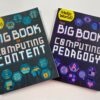Pedagogy Quick Reads: turning abstract ideas into classroom practice
What does outstanding computing education look like in the age of AI? We’ve just released a new series of Pedagogy Quick Reads exploring this vital question. Focusing on three aspects of AI in computing education, these short guides offer practical insights and new strategies for your classroom practice.

Each Pedagogy Quick Read is designed to help educators explore, understand, and apply one area of research evidence.
You get:
- An introduction to the topic or idea, putting it into context
- A summary of the key concepts and takeaways for educators
- Sections elaborating on each key concept and relevant research
- A diagram presenting the same ideas in visual form
- Links to referenced resources for further reading
Introducing our AI Pedagogy Quick Reads
Computational Thinking 2.0
This Quick Read explores how the concept of computational thinking is evolving, particularly in the context of AI. It offers guidance on how to teach computational thinking skills that are relevant to and enhanced by AI technologies.
“Without CT2.0, today’s learners will remain passive consumers rather than informed participants in a world increasingly shaped by data-driven AI technologies.”
Anthropomorphism
As AI becomes widely used, it’s important to consider how students understand and view these technologies. This Quick Read discusses anthropomorphism (attributing human-like qualities to AI) and provides strategies for teaching about AI in a way that avoids common misconceptions.
“If young people see this technology as innately human-like, we run the risk of impacting their…sense of agency…safety…social connection…curiosity.”
Feedback Literacy
Effective feedback is important for student learning, especially in a rapidly changing field like AI. This Quick Read examines how to develop “feedback literacy” in both educators and students, enabling them to give, receive, and use feedback more effectively.
“How do we ensure that all students get the most out of AI system-produced feedback? Feedback literacy is a theory-driven framework that can help…answer this question.”
Browse our library of pedagogy resources
The new AI-themed reads join our bank of other Pedagogy Quick Reads, which cover a wide range of topics related to computing education. You can find these resources and more on our pedagogy page, all organised around our 12 pedagogy principles for computing education.

Other resources
As well as our Pedagogy Quick Reads, we also offer lots of other resources to support computing educators:
- The Hello World Big Book of Computing Pedagogy is an in-depth guide to research-backed computing education pedagogy, covering a wide range of topics and offering practical advice for teachers.
- The Hello World magazine and podcast feature insights from educators in computing education, exploring current research, best classroom practices, and innovative teaching strategies.
- Our AI literacy programme, Experience AI, provides teachers with cutting-edge resources on AI and machine learning, based on proven pedagogical principles to support effective learning and teaching.










No comments